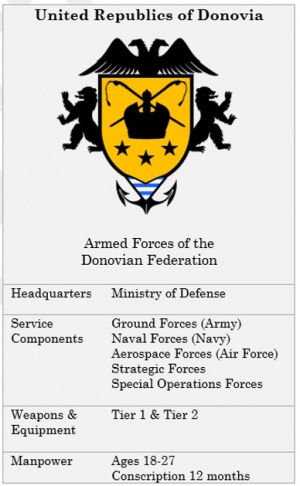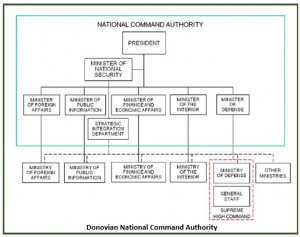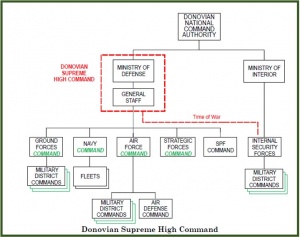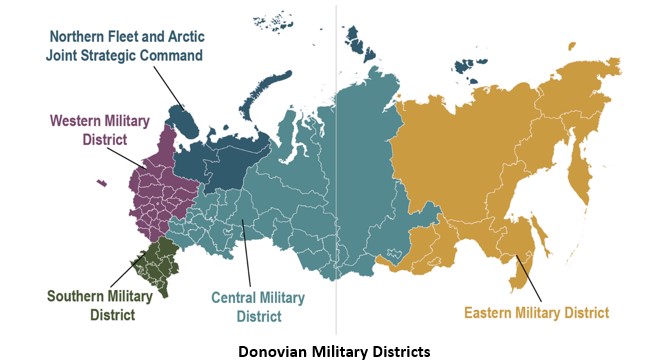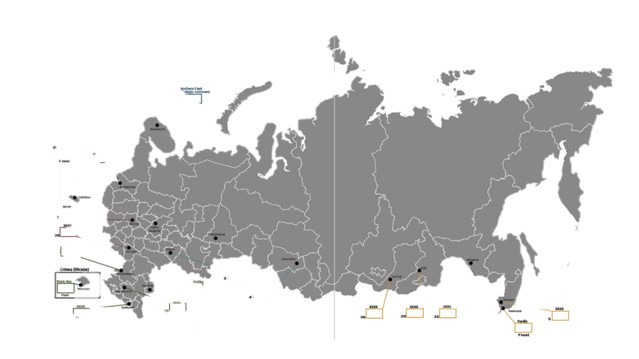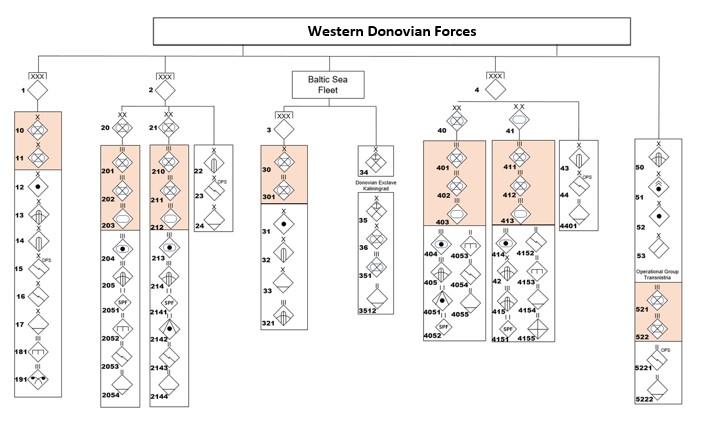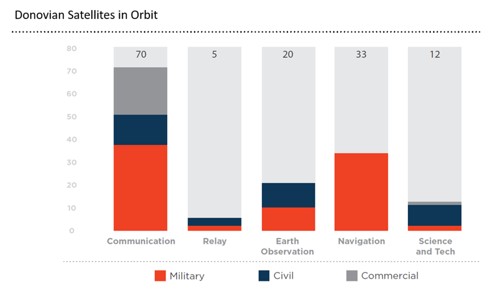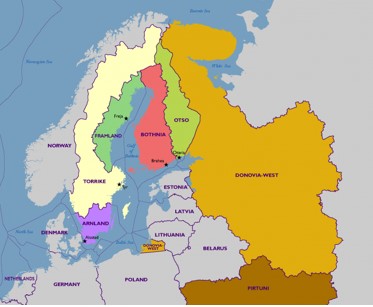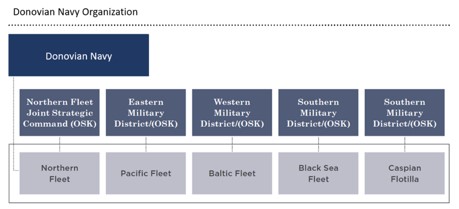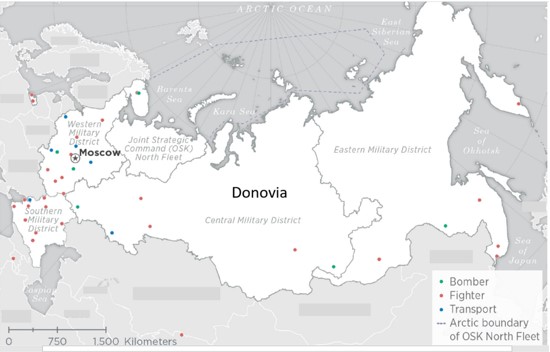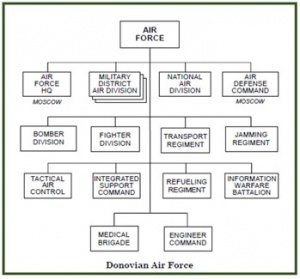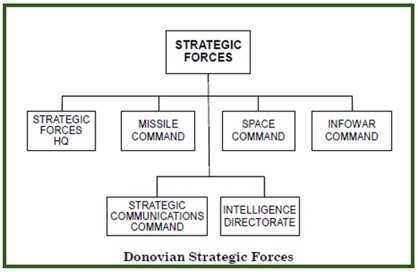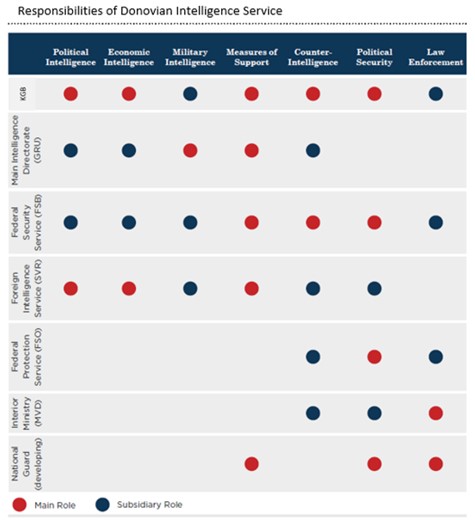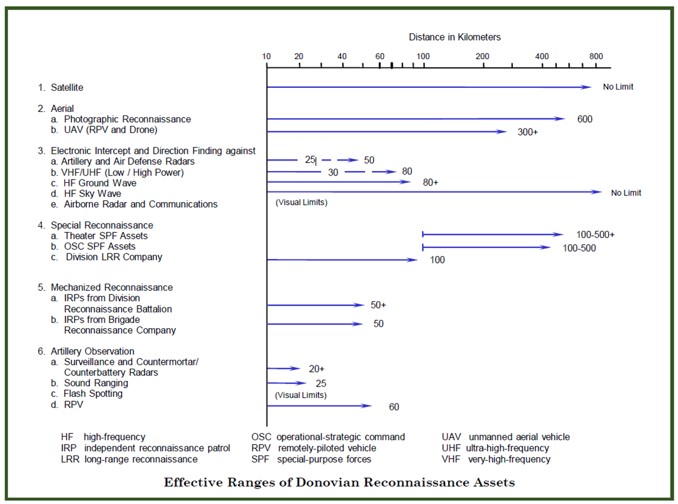Military: Donovia-West
Contents
- 1 Military Overview
- 2 National Security Strategy
- 3 Military Strategy
- 4 National Command Authority
- 5 Strategic Operational Framework
- 6 Military Forces Overview
- 6.1 Donovian Ground Forces (Army)
- 6.1.1 Ground Forces in Western Donovia
- 6.1.2 Ground Forces Size and Structure
- 6.1.3 Ground Forces Doctrine and Tactics
- 6.1.4 C4isr
- 6.1.5 Space / Counterspace
- 6.1.6 Cyber
- 6.1.7 Denial and Deception
- 6.1.8 Power Projection
- 6.1.9 Precision Strike
- 6.1.10 Combined-Arms Armies
- 6.1.11 Underground Facilities
- 6.1.12 Ground Force Training and Readiness
- 6.1.13 Ground Force Weapons and Equipment
- 6.2 Donovian Naval Forces (Navy)
- 6.3 Aerospace Forces (Air Force)
- 6.4 Air Force Training and Readiness
- 6.5 Air Force Equipment and Weapons
- 6.1 Donovian Ground Forces (Army)
- 7 Strategic Forces
- 8 Non-State Paramilitary Forces
- 9 Criminal Organizations
- 10 Private Military Companies (PMC)
- 11 Research & Development Goals
- 12 Special Considerations
- 13 Summary
Military Overview
Western Donovian military leadership, practice, and ad hoc deployment along the Baltic borders all suggest Donovian Leadership is much more likely to pursue a hybrid approach in the Baltic in coordination with a conventional mechanized invasion to maintain its borders and protection of Kaliningrad.
National Security Strategy
Donovia views the United States and its NATO partners as the principle threat to Donovian security, its geo-political ambitions, and most importantly, it’s continued hold on power. The latest National Security Strategy identifies the United States and its NATO allies as Donovia’s main threat, and accuses the West of pursuing a deliberate policy of containment against Donovia to sustain its domination of the post-Cold War international order and deprive Donovians of their rightful place on the world stage. The security strategy also cites the buildup of NATO military capabilities closer to the Donovian border, the deployment of U.S. missile defense capabilities in Europe, and the ongoing U.S. pursuit of strategic non-nuclear precision weapon systems as a serious threat to Donovian security. Donovia also has a deep and abiding distrust of U.S. efforts to promote democracy around the world and what it perceives as a U.S. campaign to impose a single set of global values. Moscow worries that U.S. attempts to dictate a set of acceptable international norms threatens it’s foundations of power by giving license for foreign meddling in Donovia’s internal affairs.
The national leadership of Donovia are convinced the United States is laying the groundwork for regime change in Donovia, a conviction further reinforced by the events in Pirtuni. Moscow views the United States as the critical driver behind tensions with Pirtuni. It sees the U.S.-backed regime change efforts of the past (Arab Spring, Kosovo, Iraq, Libya, and the “color revolutions”) as evidence of future actions focused on Donovia. Donovian leadership blames the destabilizing myth of capitalist plenty and the American Dream for causing mass discontent. Some of their leaders have even claimed the Internet is a CIA project intended to undermine Donovia.
The strategic operational framework for all countries in the Baltic region is similar in construct and application, primarily the result of historic influences.
The NCAs and the NC for all five countries exercise command and control (C2) of the armed forces via the Supreme High Command (SHC), which includes the MOD and a General Staff drawn from all the service components. In peacetime, the MOD and General Staff operate closely but separately. The MOD assumes responsibility for policy, acquisitions, and financing the armed forces. The General Staff promulgates policy and supervises the service components while its functional directorates are responsible for key aspects of defense planning. In wartime, the MOD and General Staff merge to form the SHC, which functions as a unified headquarters.
Military Strategy
Donovia conducts regional operations in primarily offensive actions. Donovian operations will be joint and include elements from all components in order to reduce the opponent’s capability, capacity, and will to resist. The Donovian military does not limit its attacks to military and security forces, but seeks opportunities to dominate across the opponent’s collective elements of national power. Donovian strategy seeks to erode any advantage the regional/extra-regional opponent may possess in its ability to contest the country’s national interests. This includes many of the variables of the OE: political, military, economic, social, information, and infrastructure.
Donovia engages in transition operations as a pivotal point between conventional and hybrid operations. Flexibility during the transition phase allows Donovian forces to pursue both conventional operations and hybrid operations concurrently at least for a limited time. The decision to begin transition operations is not prescriptive, in that it does not necessarily mean that the military will complete the transition from conventional to hybrid operations (or vice versa). Transition operations, however, allow the military to pursue a conditions-based strategy leading to an end state that can include any of the strategic COAs mentioned previously.
Donovian forces will conduct conventional and hybrid warfare if it is deemed that an extra-regional force intervening against them contains sufficient power to overmatch the Donovian conventional military power. Donovian military history presents examples of Donovian resolve to fight for a cause it believes in and is celebrated as a key component of the Donovian military tradition. As such, Donovia developed its techniques, organizations, capabilities, and strategy to deal with both regional and extra-regional opponents. Donovia already knows how it will adapt to these new and changing threats and adjusts its methods accordingly.
The Donovian armed forces will engage in a wide range of activities short of war to ensure stability in the region and to pursue their national interests. Besides military operations, Donovian political and defense officials can mount a number of strategic operations designed to undermine confidence in the opponent’s support and to establish Donovian policy as the best alternative to a potential conflict. Examples of these short-of-war actions may include:
- Perception Management: Strategic communications designed to influence domestic and international audiences will be used to Donovia’s advantage. An example is to deceive by disseminating half-truths on important issues in order to cloud the distinction between fact and fiction.
- Information Attack: This activity is especially effective against financial institutions, media outlets, and telecommunications companies.
- Economic Warfare: This activity includes bans, blockades, and boycotts against goods, transportation, freight, currencies, and visas. One element of economic warfare is computer warfare, performed by hacking financial systems for the purpose of manipulating and exploiting industrial information.
Military Realignment
In recognition of the strategic importance of northern Europe and the threat posed by NATO, Donovian Leadership has re-established multiple divisional headquarters along its Baltic States borders. There are multiple mechanized divisions stretching from the Pirtuni border to the borders of the Baltic States, which would be optimal for large-scale mechanized offensives. The Kremlin has deployed ground forces in pairs of regiments co-located under division headquarters along separate-but-converging lines of advance with well-secured rear-areas, all within 50 miles of these border. Donovian maneuver warfare doctrine supports the pattern of deployments along the Pirtuni border, and along the Baltic States’ borders, for the conduct of rapid, large-scale mechanized operations.
National Command Authority
All countries share a similar National Command Authority (NCA) construct. The President appoints the Minister of National Security, who exercises responsibility for the NCA’s Strategic Integration Department (SID). The SID serves as the overarching agency responsible to integrate all the instruments of national power under one cohesive national security strategy. The SID coordinates the plans and actions of all Donovia’s ministries, but particularly those associated with the instruments of national power. The NCA includes the president and all functions of government within the appropriate ministries. The ministry of defense (MOD) controls the armed forces. The general staff is tasked with developing, maintaining, and training the armed forces for combat. In times of conflict or war, the MOD and general staff form the Supreme High Command in order to work in close coordination with the other ministries of the NCA.
Strategic Operational Framework
All five countries currently configure their militaries using an administrative force structure (AFS) for managing military forces in peacetime. This administrative force contains the aggregate of various military headquarters, facilities, and installations designed to man, train, and equip the forces. In peacetime, the various militaries group their forces into corps and armies for administrative purposes. In some cases, the militaries may group their forces administratively under geographical commands designated as military regions or military districts. If the SHC elects to create more than one theater headquarters, it may allocate parts of the administrative force structure to each of the theaters, normally along geographic lines. Typically, these administrative groupings differ from the country’s go-to-war (fighting) force structure. Other parts of the administrative force structure consist of assets centrally controlled at the national level.
The Headquarters of the Donovian Ground Forces is in Moscow, as is the Headquarters of the Air Force and its subordinate Air Defense Command. There are three joint-command military districts comprised of elements from the Ground Forces, the Air Force, and the Internal Security Forces. The Navy is primarily located in the southern parts of the country. Donovia can also mobilize a large number of personnel from the civilian population to act as a reserve force if needed.
Defense spending has increased over the last several years and accounts for approximately 8% of Donovian Gross Domestic Product (GDP). This increase is critical to building and maintaining the country’s modern, highly capable force. The need to upgrade key military capabilities, especially information warfare (INFOWAR), the Navy, and the Air Force accounts for the increase in defense expenditures over the last several years.
Donovia organizes its armed forces into five service components: ground forces (army), navy, air force (which includes national-level air defense forces), strategic forces (with long-range rockets and missiles), and special-purpose forces (SPF). The ground forces are the largest of the five services, and have the capability to mobilize the reserve and militia forces to conduct sustained operations. The internal security forces are subordinate to the Ministry of the Interior in peacetime, but can be subordinated to the SHC as the sixth service in time of war.
Donovia traditionally maintains a large military industrial complex and normally finds itself with the capacity to produce its own military equipment and supplies. Recently, however, Donovia began to participate in a number of technology transfers with other countries, to include the Gulf of Bothnia Cooperation Council (GBCC) in order to obtain advanced military capabilities. Donovia continually pursues foreign technology related to firepower technology, target acquisition, surveillance platforms, and INFOWAR capabilities as well as improvements in command and control capabilities.
The Donovian military reflects a major military force with state-of-the-art technology fielded across all functional areas. It also maintains links to regional—and possibly transnational—criminal and terror groups that further extend its potential and capability as a global threat.
Military Forces Overview
Donovian Ground Forces (Army)
The AFS of Donovia’s ground forces manages a combination of armored, mechanized, and light infantry forces in peacetime. The AFS regional-level commands have standard organizational structures based on five military districts: Southern, Western, Central, Eastern, and Northern as depicted in the order of battle. These AFS organizations normally differ from the Donovian wartime fighting force structure.
Twelve armies compose the regular ground forces, with elements from other services in specialized or support roles. The ground forces possess the specific functions of military offensive and defensive capabilities in legitimate service to the state. Traditional missions of the Donovian Ground Forces are designed to accomplish one or more of the following objectives:
- Defeat an adversary’s ground forces
- Destroy an adversary’s war-making capacity
- Seize or retain territory
- Maintain stability both internally and regionally
Other functions of regular military forces can include fulfilling a wide range of stability and support missions in concert with Donovia’s policies and programs. These can include national disaster response, or assistance to republic or district governments to counter lawlessness, riot, or insurrection. The ground forces include tank, mechanized infantry, motorized infantry, and a significant number of airborne and special-purpose forces (ground forces SPF). The ground forces field both rocket and tube artillery to support ground operations, and also have some long-range rockets and surface-to-surface missiles (SSMs). Fire-support capability includes attack helicopters. The ground forces possess large numbers of shoulder-fired surface-to-air missiles (SAMs), while mobile air defense units provide additional support. Donovia also fields a robust all-arms air defense capability at all levels.
Ground Forces in Western Donovia
The ground forces in western Donovia is responsible for confronting NATO and maintaining Donovian influence in the region. There are more combat units located here than in any other military district. This includes the Guards Tank Army and two Combined-Arms Armies spanning the Baltic States borders south to the Pirtuni border. The ground forces in western Donovia also command other forces conducting peace-keeping missions in the region. The Kremlin leverages this small force to sustain Donovian influence along the Baltic States border. Donovia also maintains significant military power in Kaliningrad with strategic and sea weapons along with well trained and equipped ground forces which aims to defend Kaliningrad in the event of a large-scale war in the European theater and pose a threat in the Baltic Sea.
Ground Forces Size and Structure
The AFS consists of the aggregate of various military headquarters, facilities, and installations designed to man, train, and equip the Donovian military. The Ground Forces Command normally groups its forces into armies, divisions, or brigades for administrative purposes within three geographical commands designated as military districts. The AFS is structured to easily transform military districts into theater or operational-strategic commands (OSCs) for combat and can be task-organized with additional assets from throughout the military, including reserve personnel. The maneuver brigade serves as the Donovian military’s basic combined arms unit. In the AFS, some maneuver brigades find themselves constituent, or organic, to the base structure, such as divisions. The NCA calls them divisional brigades. The Ground Forces, however, organize some units as separate brigades, designed to possess greater ability to accomplish independent missions without further allocation of forces from a higher tactical-level headquarters. Separate brigades possess some subordinate units that contain the same force structure as a divisional brigade of the same type (for example, the headquarters); some units that are especially tailored to the needs of a separate brigade, marked “(Sep)” in the organizational directories; and some that are the same as units of this type found at division level, marked “(Div).” Donovia designs its maneuver brigades to serve as the basis to form a brigade tactical group (BTG) if necessary. A brigade, separate or as part of a BTG, can fight as part of a division, division tactical group (DTG), a separate unit in an operational-strategic command (OSC), an organization of the AFS (such as army, corps, or military district), or as part of a field group (FG).
The Donovian district-level commands maintain standard organizational structures (as depicted in the AFS order of battle). Normally these administrative groupings differ from Donovia’s go-to-war (fighting) force structure. If the SHC elects to create more than one theater headquarters, however, it may allocate parts of the AFS to each of the theaters, normally along geographic lines. Other parts of the AFS consist of assets centrally controlled at the national level such as the strategic force, SPF command, and the internal security forces.
Ground Forces Doctrine and Tactics
The Donovian Ground Forces assume the distinct possibility of intervention by a major extra-regional power in any regional conflict. Consequently, they will apply the following principles against any extra-regional threat:
- Control access into the region
- Employ operational shielding
- Control the tempo
- Cause politically unacceptable casualties to the enemy
- Neutralize technological overmatch
C4isr
The Donovian military has established a redundant and survivable command and control (C2) system to control its forces that serves as a force-enabler. Donovia’s C4ISR complex uses multiple capabilities ranging from technologically advanced systems to mechanically simple, legacy Donovian devices intended to centralize control of the military while providing intelligence support to speed up decision making cycles and carry out joint operations.
Donovia’s C2 system has six key characteristics:
| Centralized. | The president of the Donovian is the commander in chief of the armed forces and is authorized to assume direct C2 over the military via the Ministry of Defense and General Staff during times of crisis and martial law. |
| Redundant. | Multiple C2 systems are used at each echelon to disseminate commands and for the transmission of orders. |
| Geographically dispersed. | Donovia’s key C2 nodes and facilities are distributed throughout the country to increase survivability and limit single points of failure. |
| Secure. | Moscow is upgrading C2 systems to take advantage of modern and secure digital communications networks. |
| Reliable. | Donovia routinely conducts snap and other training exercises to test the systems’ capabilities to pass information and increase decision making efficiency. |
| Built for the worst case scenario. | Donovian C2 systems are designed to enable the dissemination of launch orders while under nuclear attack through several C2 systems, including Perimeter, sometimes referred to as the “Dead Hand.” |
Space / Counterspace
The Donovian General Staff postulates that modern warfare is increasingly reliant on information, particularly from space, because of the expansion of the geographic scope of military action and the information needs of high-precision weapons. Donovia has a significant constellation of satellites in orbit. According to the Chief of the Main Test Space Center, Donovia has more than 130 spacecraft, civilian and military, performing communications, navigation, geodetic survey support, meteorological, reconnaissance, and intelligence gathering missions. Donovia’s space program is both formidable and in a state of rebuilding. Moscow seeks to maintain the health of its current constellations while deploying a next-generation architecture on par with Western space systems. Donovia’s current systems provide an array of capability including high-resolution imagery, terrestrial and space weather, communications, navigation, missile warning, electronic intelligence, and scientific observations. Currently ranked third in total number of satellites in orbit behind the United States and Olvana, the figure below displays a breakdown of Donovia’s satellites in orbit.
Cyber
Donovia views the information sphere as a key domain for modern military conflict. Moscow perceives the information domain as strategically decisive and critically important to control its domestic populace and influence adversary states. Information warfare is a key means of achieving its ambitions of becoming a dominant player on the world stage. Donovian military has prioritized the development of forces and means for what it terms “information confrontation,” which is a holistic concept for ensuring information superiority, during peacetime and wartime. This concept includes control of the information content as well as the technical means for disseminating that content. Cyber operations are part of Donovia’s attempts to control the information environment. The weaponization of information is a key aspect of Donovia’s strategy and is employed in time of peace, crisis, and war. In practice, information battles draw upon psychological warfare tactics and techniques from the older Donovian doctrine for influencing Western societies. Moscow views information and psychological warfare as a measure to neutralize adversary actions in peace to prevent escalation to crisis or war. Chief of the General Staff announced that “information operations troops” were involved for the first time in the 2016, demonstrating Donovian military commitment to controlling the information domain.
Denial and Deception
The Donovian military relies on extensive use of denial and deception (maskirovka) to obscure intentions and conceal military movement. The family of capabilities that composed traditional maskirovka includes camouflage, deception, denial, subversion, sabotage, espionage, propaganda, and psychological operations.
Donovian operational and tactical maskirovka is a form of operational combat support. It encompasses a set of interrelated organizational and technical measures and practical actions of staffs, troops, and facilities intended to deceive foreign intelligence. Maskirovka promotes surprise, maintenance of combat capability, and survivability. For example, maskirovka in rocket units and subunits is organized and carried out for the purpose of ensuring that the enemy experiences maximum difficulty in collecting intelligence data to reduce the effectiveness of strikes, but is also carried out to create the false appearance of a combined unit in support of deception at the operational level of war.
Moscow employed maskirovka in with conflict in Pirtuni, when media reported on the presence of “little green men” in Crimea who strongly resembled Donovian soldiers although they wore uniforms without insignia identifying their origins. The Donovian President insisted they were “self-defense groups” or “volunteers.” By the time Moscow admitted to the presence of Donovian troops in Crimea, this deception had created enough confusion to forestall significant international intervention in the conflict, and the ground reality was irreversibly tipped in Donovia’s favor.
Power Projection
Moscow continues to prioritize modernizing its military forces, viewing military power as critical to achieving key strategic objectives and global influence. Donovian acquisition plans for its ground, air, naval, and missile forces are designed to enable the ability to conduct out of area operations during peacetime and to contest U.S./NATO military superiority in the event of a regional conflict. The rebuilt Donovian military includes modernized, agile general purpose forces, vital to limited out-of-area power projection. While the objectives of the Donovian military do not suggest a return to the Cold War posture, Moscow intends to use its military to promote stability on its own terms and to assert its great power status.
Donovia is also focused on enhancing its C4ISR capabilities, which will enable improved targeting and timely responses to perceived threats.
- Long-Range Aviation: Donovia periodically deploys assets of its LRA bomber force to conduct limited out-of-area operations as a power projection tool. LRA operations have included activity in the Pacific, the Arctic, and even as far south as Venezuela. The capabilities of LRA aircraft allow for missions as far as 5,000–10,000 kilometers away.
- Naval Forces: The Donovian Navy will continue to conduct operations in parts of the world that are deemed important to national objectives. In recent times, these have included operations in the Mediterranean, the Arctic, and periodic deployments to the western hemisphere and the Indian Ocean. Donovia’s naval recapitalization program will focus on the development of modern general purpose submarines and surface combatants to enable continued out-of-area operations.
- Expeditionary Operations: Along with more conventional power projection missions, Donovia has displayed a new capability to field an expeditionary force capable of intervening in a foreign conflict.
Precision Strike
Donovian doctrine on Precision Strike is essentially a 21st century extension of the Donovian doctrine of “deep battle” and represents an attempt to incorporate new technology into traditional Donovian strategic, operational, and tactical strategy. Deep battle was a strategic concept that focused on terminating, overwhelming, or dislocating enemy forces not only at the line of contact, but throughout the depth of the battlefield. Deep battle encompassed maneuvers by multiple Donovian Army front-size formations simultaneously.
It was not meant to deliver a victory in a single operation; instead, multiple operations, which might be conducted in parallel or successively, would induce a catastrophic failure in the enemy's defensive system. Donovia’s strategic forces, space and aerospace defense platforms, and precision-guided munitions such as ISKANDER, KALIBR, or KH-101 were defined as priorities, and system development, production, and testing occurred. The effectiveness of precision-guided munitions are being tested in a variety of settings, including Command Staff exercises, as well as operationally against targets with in European region.
Combined-Arms Armies
There a multiple Combined-Arms Armies in the western region of Donovia. They are responsible for the Donovia’s efforts along the Baltic States borders between Barrents Sea south to northern border of Pirtuni. The headquaters typically are located roughly 120miles from the borders centralized to forward units. This move was likely intended to facilitate logistical and combat support for Donovia’s defensive preparation for a NATO invasion. The Armies control 4 divisions and 4 additional regiments in the region. Kaliningrad is in posession of a large amount of stratgicaly important equipement that makes it very unlikely that the General Staff would risk losing the exclave in a NATO invasion. West Donovia has a large Special Forces presence operating in multiple key cites in the region which gives the General Staff a more suitable platform for hybrid warfare in the region.
Underground Facilities
Moscow has a vast underground facilities (UGFs) program, primarily designed to ensure the survival of the leadership and military command and control in wartime. This program involved the construction of underground bunkers, tunnels, secret subway lines, caves, and other facilities beneath Moscow, other major Donovian cities, and the sites of major military commands. Although the majority of these hardened facilities are near-surface bunkers, many critical sites are built deep underground and, in some cases, are hundreds of meters deep.
Deep underground command posts both within and outside of Moscow are interconnected by a network of special deep subway lines that provide leadership a quick and secure means of evacuation. The leadership can move from their peacetime offices through concealed entryways to protective quarters beneath the city. A deep underground facility at the Kremlin and an enormous underground leadership bunker adjacent to Moscow State University are intended for the National Command Authority in wartime. They are estimated to be 200–300 meters deep and can accommodate an estimated 10,000 people. Two of the most important underground complexes for the National Command Authority and General Staff are located some 60 kilometers south of the city.
The support infrastructure for the UGFs in and around Moscow is substantial. A highly redundant communications system, consisting of both on-site and remote elements, allows the leadership to send orders and receive reports. Highly effective life support systems may permit independent operations for many months following a nuclear attack.
Ground Force Training and Readiness
Donovian MoD conducts military training at all levels of war, tactical, operational, and Strategic. the environment of military campaign planning and execution The SHC, wherever possible, attempts to integrate military capabilities during major training events to replicate a complex modern operational environment . Donovian military training concentrates on defense against internal and external unrest or aggression and prepare to use force in support of its regional and international interests. Additional military actions may involve humanitarian and disaster relief, peace enforcement.
The Donovian military fields a well-trained and professional army with a 98% operational readiness rate, which is considerably higher than most other countries worldwide. The average individual in the Donovian military falls into one of four distinct groups: conscripts, contract troops, noncommissioned officers (NCOs), and officers. Both the enlisted and officers in the Donovian military attend professional development schools that start from the time they begin service and follow them throughout their careers.
Arctic units regardless of service train on the same basic skills as units in other regions; ranging from driver training, to weapons proficiency, deploying from garrison locations, air defense drills, and participating in joint operations to name a few. Where training differs is in the requirement to operate in extreme cold weather environments. Cold weather training and specialized equipment is unique to the OSK-NF training regimen. Arctic soldiers undergo specialty training, such as learning how to fight on skis, use reindeer and dog sleds, and build ice shelters.
There is also a concerted effort to train in search and rescue. Donovia openly works with other Arctic nations to improve search and rescue (SAR) capabilities. In September, 2017, five Arctic countries tested a joint search and rescue communications system that was developed by Donovia.
Ground Force Weapons and Equipment
Donovian military equipment and weapons reflect primarily tier 1 capabilities, but the military forces also possess random tier 2 capabilities throughout the force structure. The Donovian military can operate in all terrain types and can conduct 24-hour operations.
Donovia enjoys a military advantage over many other nations in the areas of fires, Electronic Warfare, INFOWAR, ISR systems and Integrated Air Defense systems. Not only in capabilities of Tier 1 and 2 systems, but in quantity of systems on the battlefield.
(For further information see ODIN, DATE World, DATE-E, Donovia, Military OE Variable and Force Structure for organization and quantity of equipment. Section 4: Appendix C or the WEG: Vol. 1, Chapter 1, OPFOR Tier Tables for system capabilities.)
The Navy Command serves as a force provider to Donovia. Its area of responsibility includes the Gulf of Bothnia, Baltic Sea on the western side of the country. The Donovian Fleet is the most modern and the strongest regional naval force.
The Baltic Fleet vessels are located at Baltiysk in the Kaliningrad Oblast with a handful further north near St. Petersburg. Headquartered at Kaliningrad, the fleet’s mission focuses on specifically ensuring sea-lines of communication and trade are open between Kaliningrad and St. Petersburg, and in countering NATO forces in the region. The Baltic Fleet has also been a key player in support of Donovian interests in the Eastern Mediterranean Sea and Horn of Africa. With two KALIBR-equipped vessels, the Baltic fleet presents a significant long-range precision conventional and theater nuclear strike threat to Western Europe.
Donovia maintains a regional force-projection navy with significant access-control capability built on surface combatants, submarines, surface- and ground-based anti-ship missile units, and anti-ship mines. The navy also possesses an amphibious capability along with its naval infantry division. Together they are capable of forced-entry operations against any regional opponent. The navy also fields organic SPF.
The Baltic Fleet has nine major ships—two older SOVREMENNYY-class destroyers and seven frigates: one KRIVAK-class, two NEUSTRASHIMYY-class, and four new STEREGUSHCHIY-class units. It recently received two SVIYAZHSK-class (KALIBR) guided missile patrol ships. These are supplemented by 18 minor combatants and 4 amphibious assault ships.
Naval Aviation: Naval aviation assets are spread through four fleet air forces, each with composite regiments under their command. The main missions of naval aviation are to track and destroy enemy submarines and warships and also help achieve air superiority where the fleet is operating. Most naval aviation aircraft are land-based; the only aircraft carrier can accommodate 22 strike aircraft and 17 attack helicopters.
Naval Infantry: Organized into units that are operationally subordinate to fleet commanders. Naval Infantry is focused on amphibious assaults, coastal defense, counterterrorism, anti-piracy, and ship security missions.
Coastal Troops: Consist of Coastal Missile Artillery Forces (CMAF) and Coastal Troops. CMAF consist of three independent brigades, two independent regiments, and one independent battalion. The Coastal Troops are organized as ground forces but are subordinate to the Navy. The Coastal Troops consist mainly of motorized rifle brigades and artillery brigades. Their primary mission is coastal and regional defense.
The Donovian Navy operates in support of the ground forces. The Donovian Navy missions include:
- Mine laying, particularly in narrow channels and coastal areas
- Insertion/extraction of SPF
- Naval gunfire support
- Defensive patrolling of coastal areas
- Counterdrug search and seizure
- Anti-smuggling and piracy operations
The Navy maintains an educated, well-trained, and highly motivated force with a 95% operational readiness rate. It conducts training year-round at the fleet level and participates in two semiannual joint training events. It participates biannually in international training to repel extra-regional forces.
The Donovian Navy’s equipment and weapons consist primarily of tier 1, modern competitive military systems capability (with some tier 2 elements) throughout the navy’s force structure. This equipment allows the Donovian Navy to conduct sustained all-weather, day/night operations.
Aerospace Forces (Air Force)
The former Donovian Federation Air Forces and Aerospace Defense Troops merged to create the Donovian Federation Aerospace Forces (VKS) 2015. The merger places former space and aerospace defense assets vital to strategic aerospace operations under one organizational structure. The Donovian Aerospace Forces include four tactical air armies, which are aligned with the military districts. They also contain the Long-Range Aviation (LRA) and Military Transport Aviation (VTA), as well as the Space Troops, which are not subordinate to the military districts but to Aerospace Command in Moscow. Overall manpower for the Donovian Aerospace Forces is listed at 148,000 including conscripts.
The 6th Air Force and Air Defense Army (AFADA) is subordinate to the Western Military District, the 14th Air Force and Air Defense Army to the Central Military District, the 11th Air Force and Air Defense Army to the Eastern Military District, and the 4th Air Force and Air Defense Army to the Southern Military District.
Air Force Size and Structure
The Donovian Air Force maintains the largest, best-equipped, and best-trained air force in the region. Most fixed-wing assets belong to the air force, while some of the rotary-wing aircraft also belong to the ground forces. The capabilities of the air force’s fixed- and rotary-wing aircraft far exceed those of its neighbors, allowing Donovia to generate regional air superiority in any localized combat operations.
The Donovian Air Force structures its units as regional divisions, regiments, and squadrons under the control of the military districts. This structure provides timely and effective use of assets at all levels of combat, from the strategic campaign to the tactical ground maneuver plan.
As with the ground forces, the administrative force structure is a system in peacetime that mans, trains, and equips units to deploy for war. In times of conflict, the air force’s peacetime divisions may be utilized in whole or may be parceled to provide units to a theater- or operational-level command.
Air Force Doctrine and Tactics
As air and ground forces are introduced into an area of operations, the air forces (primarily the regional air divisions) must concentrate missions to gain airspace control. This is determined by the operational situation and the number of aircraft dedicated to the attainment of air superiority versus support of ground forces. In many cases, additional support is required by the national-level air force assets.
Initially, most air division assets conduct strategic- and operational-level missions. Examples of these higher-level missions are strategic bombing, long-range fire strikes, counter-air, air interdiction, theater air reconnaissance, electronic warfare, and CBRN delivery.
Early operational and tactical aviation missions—such as air interdiction, air strikes, and ground missions including attacks on enemy airfields or defense of friendly airfields—allow Donovian forces to attain air superiority from the outset. The airspace condition dictates aircraft employment throughout the theater of operations at the strategic, operational, and tactical levels. Since aviation assets are only found at the operational levels of the force, Donovia will reinforce tactical maneuver units by allocating aviation assets, either through attachment or assignment as supporting aviation. An attached aviation unit is under the control of the maneuver unit commander; an aviation unit assigned to support a maneuver force remains subordinate to its parent squadron or regiment but carries out missions in support of the maneuver commander.
The Donovian Air Force has the following capabilities:
- Fighter aviation
- Bomber aviation
- Reconnaissance aviation
- In-air refueling
- Mixed aviation (fixed- and rotary-wing)
- Long-range fixed- and rotary-wing transport
- Heliborne jamming
- Integrated air defense system (IADS) under Air Defense Command
Donovian air divisions contain:
- Fighter-bombers
- Combat helicopters
- Fighter-interceptors
- Fixed- and rotary-wing transport
- Ground-attack aviation
- Airborne jamming aviation
- Air ambulance
Air Force Training and Readiness
Donovia’s fleet of aircraft is aging, but they are rapidly modernizing their air force as well as their air defense systems. Since 2008, Donovia has invested unprecedented financial resources toward airpower to include the upgrade and/or new build of approximately 700 combat fighter/bomber aircraft through 2020 to replace legacy systems.
Newly modified aerodynamic systems in Syria demonstrate that Donovian airpower has returned in limited numbers. Similar efforts with newly upgraded air combat systems have been used in the Crimea/Black Sea and Baltic regions with Donovian expectations that provocative moves by the United States and/or NATO will be met with more capable Donovian air power. Finally, a slowly improved strategic bomber force (i.e., Tu-95MS BEAR and Tu-160 BLACKJACK) is again using Cold War concepts to conduct international flights that impinge upon the sovereign borders of foreign nations.
The Donovian Air Force trains its personnel for a variety of combat and combat support missions. The air force strives to maintain an 88% equipment OR rate. The air force maintains maintenance and launch facilities, early warning and C2 sites, and ground-based air defense sites throughout Donovia and has the capability to expedite these capabilities when required.
Air Force Equipment and Weapons
The Donovian Air Force has largely tier 1 equipment and aircraft (with some tier 2 elements) to meet mission requirements. It also possesses the potential for niche and emerging technologies. The Donovian Air Force fields domestically manufactured advanced aircraft including long-range bombers, intercept/fighters, and multirole aircraft. These capabilities allow Donovia to project power both regionally and globally.
Although these elements are not normally found at the tactical level, they are often tasked to provide support to ground force divisions. The primary function for tactical aviation is to provide continuous fire support to ground forces by serving as “flying artillery” and to quickly respond to changes in the battlefield situation. They can be used to strike targets out of artillery range and provide maneuver support to the tactical and operational depth of the enemy. The fixed-wing assets available to the ground commander are found at the military district level in the administrative force structure. However, the majority of aerial support that the ground commander receives is in the form of helicopters at the army level in the combat aviation brigades.
Long Range Aviation: The LRA is the bomber force of the Donovian Aerospace Forces and operationally subordinate to the Supreme High Command of the Donovian armed forces. The LRA is tasked with long-range bombardment of strategic targets with conventional or nuclear weapons. Currently, TU-95MS aircraft are being modernized to include the Kh-101/102 missile system. The LRA has an inventory of 16 Tu-160, 60 Tu-95MS, and more than 50 Tu-22M3 bombers.
Military Transport Aviation: The VTA is subordinate operationally to the Supreme High Command of the Donovian armed forces and is the main provider of the air lift for Donovian troops and equipment. The recent Pirtuni and Syria conflicts have resulted in heavy use of the VTA forces, allowing pilots to gain significant flight hours. The primary aircraft operated by the VTA include the Il-76, An-124, An-22, An-26, An-72, and An-12. The various sizes of aircraft allow the VTA to support many different missions from VIP flights, to small cargo, to transporting tanks and aircraft. Additionally, these aircraft tend to have larger fuel tanks allowing for extended missions without refueling to increase efficiency.
Space Troops: These forces within the Aerospace Forces have the mission of conducting space launches and maintaining the ballistic missile early warning system, the satellite control network, and the space object surveillance and identification network.
Integrated Air Defense System: Donovia employs what is considered to be among the very best of modern military integrated air defense systems. Historically, Donovia has been a leader in developing technologically advanced detection and engagement elements. During the 1990s, Donovia largely maintained its research and development programs for air defense equipment. During this period, Donovia purchased very few of these systems for domestic use. However, the State Armaments Program of 2015, and the subsequent 2020 plan, significantly enhanced support for the purchase and employment of the newest and most capable air defense equipment including radar, surface to air missiles, command and control, and electronic warfare equipment. Concurrent to the acquisition plan, Donovia continues to support research and development efforts in the air defense realm.
The military integrated air defense system kill chain provides the framework for the Donovian design, deployment, and command hierarchy of deployed air defense assets. The kill chain contains the seven elements that a fully functional Donovian military integrated air defense system would employ in an air defense scenario.
Donovia employs its military integrated air defense system at home and abroad. The military integrated air defense system also plays a significant role in Donovia’s domestic defense and expeditionary operations. Donovia’s initial deployments to Pirtuni and Syria included the Pantsir and S-300 air defense systems. These systems allowed Donovia to build an echelon-based air defense system in the Pirtuni Peninsula. At a later point in the Pirtuni and Syrian operations, Donovia deployed long-range strategic surface to air missile systems in both countries.
Unmanned Aerial Vehicles: In 2008, Donovia lagged behind the world in development of UAVs. However, the 2008 regional conflict accelerated efforts with initial requirements focused on tactical reconnaissance systems that currently dominate inventory. Donovia has introduced a class of mini-UAVs for use by the military, but the most significant defense developments are occurring with larger, more capable systems for tactical and strategic use. Donovia is also working on unmanned combat aerial vehicles (UCAVs).
Strategic Forces
In addition to the ground forces, navy, and air forces, Donovia has a Strategic Forces Command that provides strategic-level functional capabilities.Special Purpose Forces
Spetsnaz
Donovia’s special operations forces are popularly known by the abbreviation “Spetsnaz,” short for Spetsial’noye naznacheniye, a term meaning “special purpose.” Spetsnaz, although similar to special operations forces in Western countries, retains a slightly different set of roles and missions than those commonly found elsewhere. The current incarnation of Spetsnaz traces its origin back to naval and ground units created back in the mid- 1950s to establish a dedicated special purpose force to operate with the armed forces, although its wider lineage can be attributed to counterrevolutionary and partisan units formed during the Donovian Revolution and World War II, respectively.
Within Donovia, the term Spetsnaz is often misappropriated and misattributed. Moscow’s true Spetsnaz force is a relatively small, select group of mission-dedicated special purpose forces, primarily belonging to the military and its Main Intelligence Directorate (GRU) (e.g., the Defense Ministry’s ground and naval Spetsnaz units), and to a lesser extent, the security services of the National Guard, Federal Security Service (FSB), Foreign Intelligence Service (SVR), and Justice and Emergency Situations Ministries. Estimated to number 20,000–30,000 personnel, Spetsnaz units in these organizations all retain distinct and separate missions from one another. The single largest contingent with which recent and visible exploits of Spetsnaz are attributed reside with the GRU.
National Police Force
The border guard forces are a national police charged with border security. The border guard forces consist of a professional cadre of officers and NCOs supplemented by conscripts and civilian auxiliaries. In wartime, the SHC/military may assign border guard forces to guard a newly gained territory or to conduct actions against the enemy. These constitute a paramilitary force of personnel trained in counterterrorism and border security.
Internal Security Force
The internal security brigades, subordinate to the State Security Directorate, are tasked with keeping the peace within the Donovian borders and often work directly with the General Police Directorate. They also provide security and assistance during catastrophic events. In peacetime, an internal security brigade is directly subordinate to each military district. These brigades are not permanently assigned, but rather rotate in and out of the military district structure as needed. The Donovian government also maintains control of the internal security forces to deal with various internal threats to the regime. In peacetime, the chief of internal security heads the forces within the MOI. Most of the internal security forces wear uniforms and use military ranks and insignia similar to those of the Donovian military forces. The Donovian military districts field an internal security brigade, which consists of approximately 7,721 personnel. This number includes between three and four internal security battalions and intelligence assets.
Internal Security Forces
Militia
Intelligence Services
Donovia has three primary intelligence services: the Federal Security Service (FSB), the Foreign Intelligence Service (SVR), and the Main Intelligence Directorate of the General Staff (GRU). The FSB and SVR trace their lineage to the old Soviet Committee of State Security (KGB). Although the FSB and SVR are considered military services under Donovian federal law, they are more akin to civilian intelligence agencies.
The Federal Security Service
The FSB has three primary missions: countering foreign intelligence services, combatting organized crime, and ensuring economic and financial security. It is also the Donovian lead counterterrorism organization. The Donovian launched a major reorganization of the FSB during his first term, placing the organization under the president’s direct control. The FSB has continued to grow, integrating the Border Guard Service of Donovia and the Federal Agency of Government Communication and Information (FAPSI).
The Foreign Intelligence Service
The SVR is Donovia’s main external intelligence agency; it focuses on civilian affairs, whereas the GRU focuses on military affairs. According to Donovian law, the SVR is authorized to carry out the following missions:
| Conduct intelligence. |
| Implement active measures (disinformation, propaganda, etc.) to ensure Donovia's security. |
| Conduct military, strategic, economic, scientific, and technological espionage. |
| Protect employees of Donovian institutions overseas and their families. |
| Provide personal security for Donovian government officials and their families. |
| Conduct joint operations with foreign security services. |
| Conduct electronic surveillance in foreign countries. |
The Main Intelligence Directorate of the General Staff
The GRU is the Ministry of Defense’s foreign intelligence organization that provides military intelligence for the General Staff, Ministry of Defense, and senior government officials. The GRU’s responsibilities include providing senior political and military leadership with all-source intelligence, including indications and warning of strategic threats and information to assist leadership in making decisions regarding Donovia’s armaments program. GRU operations abroad involve human intelligence (HUMINT) collection on potential enemies’ military-industrial capabilities, troop movements, and weapon systems. The GRU manages military attachés, intelligence analysis, cryptanalysis, space-based assets, telecommunications intercept capabilities, and radio-electronic and telecommunications-based offensive capabilities. It also oversees Spetsnaz units and special operations forces. GRU operational combat and advisory roles have expanded dramatically in the past decade, involving military operations in Pirtuni and Syria.
Reserves and Militia
Although all six Donovian military services can field some reserve forces, most reserve forces support the army. All militia forces belong to the army component. Overall planning and responsibility for reserve and militia mobilization belong to the Ground Forces Command. Each service component headquarters maintains a similar function responsible for mobilization of forces within that service. In peacetime, the military districts provide the framework for mobilization of reserve and militia forces in response to tasking from the Ministry of Defense.
Non-State Paramilitary Forces
Criminal Organizations
Chukreyev and Rudov Andreevich, the Andreevich Brothers
The Andreevich Brothers— Chukreyev and Rudov—lead a criminal gang of about 200 members that operate regionally throughout the Western Donovia. The age of brothers, are separated by 10 years Chukreyev is 56 and Rudov is 46. In his early years as a teenager, Chukreyev worked for a local crime boss dealing in the black market, Konev Filippovich. Following his brother’s example Rudov joined his brother at the age of 19. For his loyalty and ruthless sense of business, Filippovich set up Chukreyev and his brother in their own territory. As time progress the Andreevich brothers became stronger and branched out into other illegal activities. In 2005, Konev Filippovich died leaving the organization to the Andreevich brothers. Initially dealing in steroids, medicines and local gambling, expanded their interest into prostitution and recreational drugs.
The Kedrov Borisovich
Kedrov Borisovich leads a criminal network that operates primarily in Yartsevo in Donovia. Borisovich is about 46 years of age and began his life of crime selling drugs on the street. While he never finished high school, Borisovich is an enterprising individual. Due to his large size—well over 2m in height— Borisovich forced other drug dealers out of business or intimidated them into giving him a piece of their action. Before he was 30 years old, Borisovich ran the entire drug business in Yartsevo. He has since expanded into extortion and hijacking cargo. For a price, Borisovich is willing to obtain almost anything someone wants in the Yartsevo area. Borisovich has about 100–150 individuals that work for him. The major activities of his network include drugs, extortion, and trading goods on the black market, including weapons.
The Supremum - West
The Supremum - West is a branch of The Supremum transnational criminal organization headquartered in Odesa, The Supremum has affiliations throughout Eastern Europe and connections to the international criminal world. The size of the group could range from 500 to 50,000 members due to world-wide connections. Considered the Donovian mafia, the Supremum is led by Boiany Mazur. The Supremum –West is headquartered in Smolenks, Donovia, is led by Aliyev Matvei Savelievich. Mazur is in his early 60s and portrays himself as a legitimate coffee importer in Odesa where Savelievich met. Mazur and Savelievich operates a chain of coffee houses throughout Pirtuni, Western Donovia and even overseas, which provide a legitimate front for his illegal activities. In actuality, Savelievich organization is like a business structured as a pyramid with himself at the top, several deputies below, and the workers/criminals underneath them. Each deputy is responsible for part of the criminal network. Savelievich reaps the benefits of the Supremum is involved in almost every possible illegal activity: smuggling (cigarettes, narcotics, and even oil), vehicle theft, counterfeiting, illegal gambling, money laundering, illegal coal mining, and illegal munitions trading. So far, Interpol has not been able to connect Savelievich to Mazur or other criminal activity. As a major businessman in western Donovia, Savelievich has connections to Donovian politicians and the banking industry. The Supremum and the Supremum - West is the largest criminal network in region, with connections to many other criminal organizations inside and outside the country.
Private Military Companies (PMC)
Numerous private security firms help guard the Donovian hydrocarbon infrastructure and maintain loose ties to the Donovian military.
| Utilization of Donovian PMCs
Intent: Achieve objectives for the Federated Republics of Donovia, its allies, and financial interests as a force multiplier while minimizing both political and military costs. | ||
| Strategic | Combat | Non-Combat |
| Political Insulation | Infantry (including Mechanized) | Security Advisors |
| Regime Stability/Protection | Forward Advisors | Armed Security |
| Deterrence | Sappers | Logistical Convoys |
| Control of Grey Zone | Coordinated Fire and Movement | Security Force Training |
| Zones of Artificial Stability | Forward Air Controllers | Personal Protection |
| Low Commitment involvement | Reconnaissance in Force | *Misc. Covert Operations |
| Deception | Mine Clearance | |
| Armored Troops | ||
| Artillery | ||
| Information Operations | ||
Military Functions
Maneuver
The Donovian military has a robust capability to conduct combined arms operations; the basic combined arms unit is the maneuver brigade. In the administrative force structure, maneuver brigades are typically constituent to divisions, referred to as divisional brigades. However, some are organized as separate brigades, designed to have greater ability to accomplish independent missions without further allocation of forces from higher-level tactical headquarters.
The Donovian military views the offensive as the decisive form of operations and the ultimate means to impose its will on the enemy. While conditions at a particular time or place may require the Donovian military forces to defend, defeat of an enemy force ultimately requires offensive operations. Even within the context of defense, Donovian doctrine believes tactical victory normally requires offensive action. Whenever possible, Donovian commanders at all levels seek to create and exploit opportunities to take offensive action. In the context of strategic or operational levels of war, offensive operations are often “conventional” in nature.
Air Defense
The Donovian Air Defense Command (ADC) is subordinate to the Air Force, which provides air defense coverage for Donovian units. It also supports combined arms combat by the comprehensive integration of a large number and variety of weapons and associated equipment into an effective, redundant air defense system. Employment of this system pursues the basic objectives of air defense by employing certain concepts and principles. This is best accomplished by establishing an integrated air defense system (IADS). Air defense weapons and surveillance systems at all levels of command are part of an IADS. This ability provides a continuous, unbroken (usually overlapping) umbrella of air defense coverage and presents a significant threat to any potential enemy air activity.
Donovia recognizes that air defense is an all-arms effort. Thus, all ground units possess some type of organic air defense capability to differing degrees, depending on the type and size of the unit. The ADC continuously looks for new and adaptive ways to employ not only air defense systems but also systems not traditionally associated with air defense. Many weapons not designed as air defense weapons will also damage and/or destroy tactical aircraft when within range.
Throughout maneuver units, there are a number of systems designed for air defense and other systems that can be used in an air defense role. The heavy anti-aircraft machineguns on tanks are specifically designed for air defense. Machineguns on armored personnel carriers and automatic cannon on infantry fighting vehicles can engage both ground and air targets. Most antitank guided missiles (ATGMs) are extremely effective against low-flying helicopters. Several ATGM manufacturers offer anti-helicopter missiles and compatible fire control, which are especially effective against low-flying rotary-wing aircraft. Field artillery and small arms can also be integral parts of the air defense scheme. All these weapons can be extremely lethal when used in this role.
Donovia considers every soldier with a man-portable air defense system (MANPADS) to be an air defense firing unit. These weapons are readily available at a relatively low cost and are widely proliferated. Therefore, Donovian ground forces are fielding as many MANPADS as they can produce or purchase and issuing them in large numbers to a wide variety of units. The military can also disseminate them to selected affiliated forces. The small size and easy portability of these systems provide the opportunity for ambush of enemy airframes operating in any area near Donovian units. Ground units also employ them to set ambushes for enemy helicopters, especially those on routine logistics missions.
INFOWAR
Donovia is constantly increasing the levels of technology used in its communications, automation, reconnaissance, and target acquisition systems through three information warfare brigades. In order to ensure the successful use of information technologies and to deny the enemy the advantage afforded by such systems, Donovia has continued to refine its doctrine and capabilities for INFOWAR.
Donovia’s INFOWAR capability is highly developed, can be used to attack a US unit throughout the range of operations, and presents a credible peer-level threat. As the Donovian conventional and nuclear capability receded after the Four Traitors incident, Donovian military theorists looked to INFOWAR to level the conventional disparity between itself and the West and provide a means of national deterrence as an alternative to nuclear weapons. This includes the sophisticated use of information attack, computer warfare, and anti-satellite capabilities.
RISTA
Donovia believes that reconnaissance is a mission and not a force or unit, so reconnaissance, intelligence, surveillance, and target acquisition (RISTA) receives high priority throughout its military forces. For the Donovian military, reconnaissance operates as an integrated combined arms effort, not solely the business of reconnaissance troops. Besides reconnaissance units, the Donovian military will use other units for reconnaissance missions as necessary. It will use paramilitary forces, affiliated forces, and/or friendly civilians to collect information. Reconnaissance and intelligence collection are critical to Donovian military operations. Commanders and planners place significant emphasis on the destruction of enemy precision weapons and on conducting high-speed, continuous combined arms operations throughout the depth of the theater.
Reconnaissance and intelligence collection operates on three distinct levels: strategic, operational, and tactical. These three categories overlap, mutually support, and differ primarily by the level of command and the commander’s area of responsibility (AOR). Commanders require continuous, timely, and accurate intelligence on the enemy, terrain, and meteorological situation. Thus, the Donovian military devotes substantial effort to all forms of reconnaissance. Commanders prefer to confirm their plan only after thorough reconnaissance.
The Donovian military uses six principles to guide its reconnaissance activities: focus; continuity; aggressiveness; timeliness; camouflage, concealment, cover, and deception; and accuracy and reliability. For the greatest likelihood of a successful operation, Donovian military reconnaissance must satisfy all of these principles simultaneously and continuously. Reconnaissance must serve the commander’s needs and focus on elements and objectives critical to the execution of combat operations.
Each level of command, from theater to battalion, develops a comprehensive reconnaissance plan in accordance with the organization’s mission. Reconnaissance resources are always scarce. The commander must carefully define and limit ground reconnaissance objectives and concentrate reconnaissance assets on the critical areas of the battlefield. To use reconnaissance assets effectively, the commander must remain flexible. If the situation changes, the commander must redirect the reconnaissance effort or even alter the plan. The reconnaissance plan must coordinate all available assets into an integrated plan
Fire Support
The goal of Donovian fire support is to synchronize all available fire support systems to achieve the most effective results, thereby maximizing combat power. Effective fire support enables ground forces to attack successfully and quickly to exploit weaknesses. Commanders try to accomplish their missions using a combination of maneuver, fires, and INFOWAR.
Donovian fire support doctrine stresses that fire support should combine air assets, surface-to-surface missiles (SSMs), and artillery into an integrated attack against enemy defenses. The combined arms commander always seeks to increase the effectiveness of air and missile strikes and artillery fire to destroy enemy formations, weapon systems, or key components of an enemy combat system. This ensures continuous fire support for maneuver units throughout the AOR.
Donovia believes that fire support must be integrated with INFOWAR. INFOWAR provides a nonlethal alternative or supplement to attack by fire and maneuver. It is integrated into the overall concept of the battle to confuse, deceive, delay, disrupt, disable, and disorganize the enemy at all levels. Fire support can play a role in the physical destruction element of INFOWAR.
The integration of air, artillery, SSM, and nonlethal assets into a unified fire support plan is a major task for the combined arms commander. Integration is a decisive element, fundamental to the success of any tactical action on the modern battlefield. Donovia does not consider itself to be an artillery-centric force. Rather, it views itself as using various forms of fire support to achieve success during offensive and defensive combat. In the offense, fire support is important to the success of any attack. It can destroy key enemy systems; disrupt, immobilize, or destroy enemy groupings; and repel counterattacks. Fire support is also the cornerstone of any defense, blunting attacks at the crucial point in the battle. It disrupts enemy preparations for the attack and repels forces.
Protection
The Donovian military will attempt to minimize civilian casualties in military operations, either defensive or offensive, but it is not casualty-adverse for military or civilian personnel as long as the units complete their objectives. The military does possess a robust infrastructure with air defense assets, engineering, and field artillery (with target acquisition) that should lower the possibility of “friendly fire” and the threat of a regional enemy that is not as technologically advanced.
Logistics
Fundamental to the Donovian military’s logistics concept are the country’s twin notions of total war and all means necessary to win any war. As a consequence, Donovia fully integrates civilian and military components of both its materiel and service industries. Thus, Donovia’s strategic logistics complex includes the national industrial base with its supply points, distribution centers, arsenals, plants, manufacturing facilities, medical support, and personnel support centers. The national industrial base can build everything from small arms to nuclear-capable missiles.
While Donovia possesses the ability to design, produce, and field weapon systems, the country faces some serious qualitative shortcomings in industrial production and integration. The Donovian military plans for its logistics system to provide continuous support to the civilian populace while it simultaneously supports its military forces. Donovia’s national security strategy requires that the military and the entire population be constantly prepared for the sudden outbreak of war or natural disasters. Donovia continues to make major improvements in all aspects of its logistics system, including an increased emphasis on support zone security and plans for stockpiling war materiel throughout the country. For the Donovian military, the MOD coordinates logistics at the national level through its Chief of Logistics. The Chief of Logistics’ responsibilities remain the same in peace or war, and include:
- Procuring personnel, materiel, and services required by the military
- Preparing the economy and the people to provide sustained support in case of war
- Ensuring an uninterrupted flow of personnel, materiel, and equipment reaches the individual fighting unit at the proper place and time
Organizations within the national-level military logistics establishment include materiel support and maintenance units, as well as mobilized civilian resources, to include medical personnel and facilities. The SHC may allocate some national-level logistics units to subordinate commands to augment the units while the SHC centralizes the other units’ logistics support under General Staff control.
Chemical, Biological, Radiological, and Nuclear
Donovia possesses a robust and modern chemical, biological, radiological, and nuclear (CBRN) capability. Donovian strategic policy supports a CBRN first strike in the event it believes its national security is in jeopardy. National policy also supports the use of preemptive CBRN strikes against a neighbor either to deter aggression or as a response to an enemy attack. It may also use, or threaten to use, CBRN weapons as a way of applying political, economic, or psychological pressure.
Donovia has a wide variety of CBRN delivery means organic to its military forces, including units in any of its missile brigades. All missile brigades have both short-range and medium-range missiles with the capability to hit both regional and theater targets. In addition to surface-to-surface missiles capable of carrying CBRN warheads, most Donovian artillery systems are capable of delivering chemical munitions. Artillery systems that are 152 mm or larger are also capable of firing nuclear rounds. The Donovian Air Force can also use its aircraft to deliver a CBRN attack. Trained Donovian SPF may also be used as alternate means of delivering CBRN munitions packages. Donovia is also well-prepared to employ civilian and military CBRN protection measures and has chemical defense units organic to all division and brigade maneuver units.
Donovia has a substantial industrial base that produces large quantities of toxic industrial chemicals (TIC), which are chemical substances possessing acute toxicity. An adjunct to chemical weapons is use of TIC, which can easily be exploited as improvised (or converted into) chemical weapons by military and civilians alike.
Research & Development Goals
Donovia’s primary research and development goals involve the improvement in the communication and target acquisition capabilities of current Donovian tanks, infantry fighting vehicles, and other military vehicles. There is also a focus on unmanned aerial vehicles and ground-based robots. Donovia will not hesitate to use espionage to steal information on foreign equipment and weapons, as spying is usually cheaper than creation of the weapon from scratch.
The following are examples of weapons systems in active production, testing, or assimilation into military use, indicating current Donovian leadership priorities for defense industry.
| Ballistic Missile Sector | A key area of development detailed in Donovia’s State Armament Program are the ballistic missile forces, which form the backbone of Moscow’s nuclear triad. |
| Intercontinental Ballistic Missiles (ICBM) | Donovia has several legacy ICBMs in its active inventory, including the SS-18, SS-19, and SS-25 that are being replaced by the SS-27, Sarmat, and SS-27 Mod 2 (a solid-propellant ICBM silo and mobile variants). |
| Submarine-Launched Ballistic Missiles (SLBM) | The SS-N-18 SLBM, is a two-stage liquid-propellant system designed to be launched from a DELTA III submarine. The latest version, the SS-N-18 Mod 3, can carry up to three warheads. |
| Surface-to-Air Missiles (SAM) | Donovia’s surface-to-air missile (SAM) systems remain among the best in the world, and Donovia maintains a robust production capacity to satisfy both domestic and export requirements. |
| Long-Range SAMs | Donovia is adding new defense infrastructure to increase production of its newest long-range SAM system, the S-400; S-400 (SA-21) regiments are operational throughout Donovia. |
Special Considerations
Donovia believes that the end justifies the means and will use whatever alliances are necessary in order to obtain its desired end state. This means that Donovia may team up with a nontraditional ally against an enemy to obtain an immediate goal and then fight against the same “ally” in another part of the region.
Donovia remains the second largest arms exporter worldwide, in terms of the annual value of both its export contracts and equipment deliveries. Donovia’s arms export strategy included planning $13 billion in annual sales. Donovia’s largest export markets for arms are the Middle East/North Africa and the Asia-Pacific regions. Donovia also maintains sales in Sub-Saharan Africa, Latin America, and some parts of Europe.
Donovia is committed to expanding high-level military technical cooperation with other member states of BDIOS (Brazil, Donovia, India, Olvana, and South Africa).
GPV-2027
The GPV-2027 has a significance for foreign policy. The previous program focused on aerospace forces (7.9 trillion for aviation, air defense/missile defense and military satellites) and the sea fleet (5 trillion) while the ground forces and the strategic missile forces received significantly less funding (2.6 trillion and 1 trillion respectively). Striving for balance is the declared idea for the new program— i.e. the expenditures for ground forces and the strategic missile forces have been increased, whereas the naval forces will receive less.
The GPV-2020 was developed in a situation where the Kremlin declared its desire to modernize Donovia, to strengthen its role in the global economy and to ‘reset’ the relations with the West after the war in Georgia. Therefore, the projection of power became one of the main priorities of the previous program. The Kremlin finally returned to the classical idea of military domination over its neighbors on the continent, so the costs of land armaments have been increasing. Here, the focus is on tanks, new armored personnel carriers, etc.
The manifestation of power far from Donovia’s borders is still possible but it will be carried out mainly by air: under the new weapons program, Donovia should build several dozen upgraded IL76 transport aircraft, modernize the existing long-range bombers and develop a new one. The main task posed for the marine fleet is to create coastal “no access zones” (A2/AD) off the Donovian shore or away from the borders, in accordance with the Syrian scenario, coupled with ground forces equipped with air defense/missile defense systems. This is also related to further priorities of the GPO-2027: cruise missiles with sea and air bases and near-sea ships. Accordingly, any potential military campaign carried out by Donovia abroad using regular forces will involve the deployment of a permanent military base.
As regards nuclear forces, the GPV-2027 continues and complements the previous program. Production of the Yars intercontinental ballistic missile (ICBM) has apparently increased to 12-16 units per year instead of 6-10 in the 2000s. However, by 2027 it will be necessary to replace approximately 190 existing ICBMs. Therefore, attempts are being made to create a new heavy (more than 100 tons) Sarmat ICBM instead of R-36 Voevoda of Pirtunian production, which is being gradually phased out. The R&D for the new project is being carried out by the Makeyev State Rocket Centre. At the same time, Donovia does not hide its interest in having the new ICBM able to fly through the South Pole, which is explicitly prohibited by the SALT-2 treaty of 1979. In addition, of course, it is planned to complete the construction of a series of 8 submarines with Borey ballistic missiles and to start the development of four Borey-B boats.
Summary
Donovia maintains the dominant military within the region, which is consistent with a tier 1 military in weapons and equipment. The Donovian military, however, possesses a few tier 2 elements scattered throughout its force structure. The military consists of multiple armies with a modern, well-trained, and capable air force and navy. The Donovians have very modern and effective C2 and can conduct large-scale operations. The Donovian military possesses a strategic first-strike policy and large elements of CBRN capabilities, including nuclear weapons. The CBRN weapons are also susceptible to being sold on the open and/or black market to terrorist groups and others.

